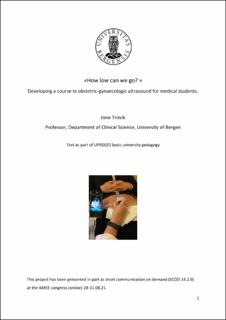| dc.description.abstract | Background: Point-of-care ultrasound investigations (POCUS) are increasingly used in primary healthcare. The University of Bergen, Norway introduced ultrasound teaching for medical students during 2017. Based on the Scholarship of teaching and learning (SoTL) principles we aimed to develop, implement and evaluate an obstetric-gynaecologic ultrasound course in the medical school curriculum.
Summary of work: A scoping literature search and stakeholders’ discussion (obstetricgynaecologist, general practitioners and medical students) identified relevant obstetricgynaecologic POCUS examinations. A pilot-study where a fourth-year medical student tested three selected procedures using the handheld ultrasound apparatus available at the Medical Skill Centre, investigated number of examinations needed to gain proficiency. A validation-study using abdominal handheld ultrasound evaluated the feasibility in confirming vital intrauterine pregnancy during first trimester. The course set-up was developed encompassing two weeks with lectures, practical apparatus instructions (knobology) but most important supervised patient examinations supplemented with not obligatory out of campus unsupervised training. Online literature and videos supplemented the teaching. Students should present in plenary selected recordings of their examinations and a brief ultrasound-related oral presentation, encouraging collaborative learning. Course evaluation included pre- and post-test (multiple choice questions: MCQ), practical test performing selected examinations and students’ oral/written feedback.
Summary of results: Bladder volume measurements, third trimester fetal position evaluation and first trimester detection of vital intrauterine pregnancy were identified as the most relevant investigations. The pilot testing suggested a minimum of 5 supervised examinations sufficient for learning bladder volume and fetal position evaluation. The minimum gestational week the handheld ultrasound apparatus could be used for early pregnancy vitality examination, was deemed undetermined. In the validation-study, two fourth-year medical students examined 100 first trimester pregnant women. They identified that from gestational week 7 vitality could be detected with 79% positive and 100% negative predictive value. Two courses were attended by 15 (in 2020) and 12 (in 2021) fifth- and sixth-year medical students. Three professors and three additional teachers were specifically affiliated with the course, in addition to clinical staff performing routine patient examinations. The MCQ results increased from median 65% correct pre-course (95% confidence interval (CI) 56-77) to median 91% post-course (95% CI 91-100, p<0.001 Wilcoxon Sign-Ranked-test). All students performed a minimum of 5 examinations per modality: median 8.5 bladder volume measurements, 8.5 early pregnancy vitality determinations and 12 fetal position examinations. At course-end 26 of 27 students considered themselves capable of performing these examinations. Of 15 students randomly selected to demonstrate a modality, all succeeded. Students deemed the course as interesting and very engaging but with a substantial workload.
Discussion and Conclusion: We have developed a two-week course in obstetric-gynaecologic POCUS using a handheld device. Using student active, collaborative learning medical students achieved theoretical and practical skills in measuring bladder volume, determine last trimester fetal position and confirming early pregnancy vitality. The course is labour intensive, both for students and teachers. The main limitation in number of course participants is the availability of sufficient patients for first trimester investigations. Ultrasound simulators with relevant modules installed might mitigate this.
Take-home messages: Bladder volume measurements, early pregnancy vitality and fetal position determination is suitable for a medical school ultrasound curriculum. | en_US |
